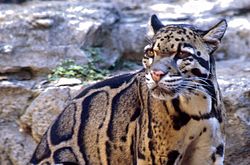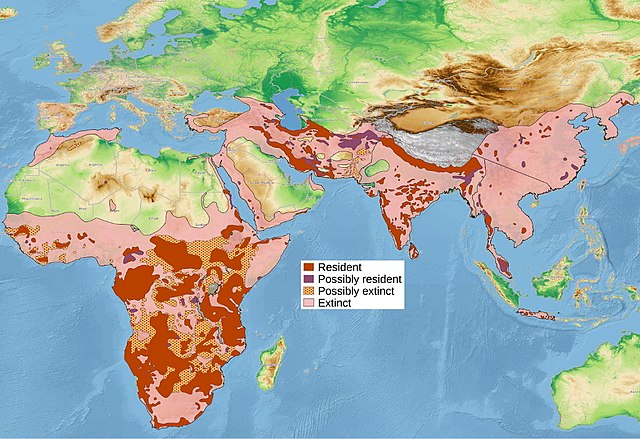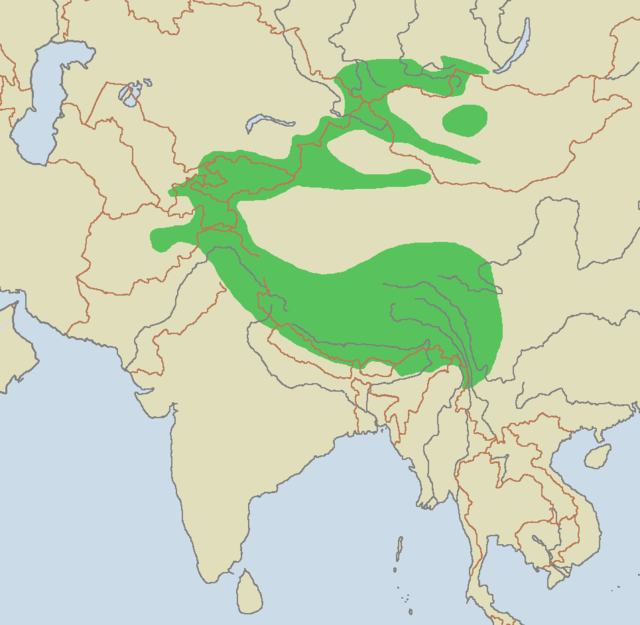Top Qs
Timeline
Chat
Perspective
Pantherinae
Subfamily of felids From Wikipedia, the free encyclopedia
Remove ads
The Pantherinae is a subfamily of the Felidae; it was named and first described by Reginald Innes Pocock in 1917 as only including the Panthera species,[2] but later also came to include the clouded leopards (genus Neofelis). The Pantherinae genetically diverged from a common ancestor between 9.32 to 4.47 million years ago and 10.67 to 3.76 million years ago.[3][4]
Remove ads
Characteristics
Pantherinae species are characterised by an imperfectly ossified hyoid bone with elastic tendons that enable their larynx to be mobile.[2] They have a flat rhinarium that only barely reaches the dorsal side of the nose. The area between the nostrils is narrow, and not extended sidewards as in the Felinae.[5]
The Panthera species have a single, rounded, vocal fold with a thick mucosal lining, a large vocalis muscle, and a large cricothyroid muscle with long and narrow membranes. A vocal fold that is longer than 19 mm (0.75 in) enables all but the snow leopard among them to roar, as it has shorter vocal folds of 9 mm (0.35 in) that provide a lower resistance to airflow; this distinction was one reason it was proposed to be retained in the genus Uncia.[6][7]
Remove ads
Evolution
Summarize
Perspective
The Felidae originated in Central Asia in the Late Miocene; the subfamily Pantherinae diverged from the Felidae between 14.45 to 8.38 million years ago and 16.35 to 7.91 million years ago.[3][4] Several fossil Panthera species have been described:
- Panthera principialis lived during the Early Pliocene around 3.7 million years ago in Tanzania.[8]
- Panthera palaeosinensis lived in the Early Pleistocene around two million years ago in northern East Asia.[9]
- Panthera zdanskyi is dated to 2.55 to 2.16 million years ago.[9] It is possibly a junior synonym of P. palaeosinensis.[8][10]
- Panthera gombaszogensis lived from about 2 to 0.35 million years ago in Europe.[11]
- Panthera youngi lived in the Pleistocene about 0.69 to 0.42 million years ago in China.[12]
- Panthera spelaea lived in Europe after the third Cromerian interglacial stage from about 450,000 to 14,000 years ago.[13]
- Panthera atrox lived in North America during the Pleistocene and early Holocene about 340,000 to 11,000 years ago.[14]
- Panthera shawi was a lion-like cat in South Africa that possibly lived in the early Pleistocene.[15]
- Panthera balamoides lived in the Yucatan Peninsula in Mexico during the Pleistocene.[16] Some researchers consider this species to be a bear instead.[17][18][19]
An additional fossil genus Leontoceryx was described in 1938.[20]
There is evidence of distinct markers for the mitochondrial genome for Felidae.[21][22]
Results of a DNA-based study indicate that the tiger (Panthera tigris) branched off first, followed by the jaguar (P. onca), the lion (P. leo), then the leopard (P. pardus) and snow leopard (P. uncia).[23]
Felis pamiri, first described in 1965 and once referred to as Metailurus in 1978, is now considered a probable relative of extant Pantherinae and was moved to the genus Miopanthera.[24] However, this species was later reassigned as a species of a different genus Palaeopanthera, of which P. blytheae is the type species.[17] P. blytheae was initially regarded as possibly the oldest known species of Panthera related to the modern snow leopard that lived during the Early Pliocene,[25] but subsequent studies have since agreed that it is not a member of or a related species of the snow leopard lineage and that it belongs to a different genus.[24][17][26]
Remove ads
Taxonomy
Summarize
Perspective
Pocock originally defined the Pantherinae as comprising the genera Panthera and Uncia.[2] Today, Uncia has been subsumed into Panthera, and the genus Neofelis is also included.[27]
Living genera
The following table shows the extant taxa within the Pantherinae, grouped according to the traditional phenotypical classification.[27]
Remove ads
See also
References
External links
Wikiwand - on
Seamless Wikipedia browsing. On steroids.
Remove ads















